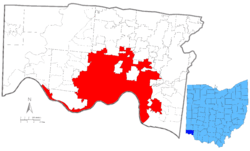Cincinnati Police Department
| City of Cincinnati Police Department | |
|---|---|
 Flag of the City of Cincinnati | |
| Common name | Cincinnati Police Department |
| Abbreviation | CPD |
| Agency overview | |
| Formed | 1859 |
| Jurisdictional structure | |
| Operations jurisdiction | Cincinnati, Ohio, United States |
 | |
| Map of City of Cincinnati Police Department's jurisdiction. | |
| Size | 79.54 sq mi (206.0 km2) |
| Population | 296,943 |
| Legal jurisdiction | Cincinnati, Ohio, U.S. |
| General nature | • Local civilian agency |
| Headquarters | Cincinnati, Ohio |
|
| |
| Police officers | 1,000 |
| Unsworn members | 125 |
| Agency executive |
|
| Website | |
| http://www.cincinnati-oh.gov/police/ | |
The Cincinnati Police Department is the primary law enforcement agency of Cincinnati, Ohio. The department has 1,057 sworn officers and 281 non-sworn employees.
History
When Cincinnati incorporated, as a village, in 1802, a ‘night watch’ was established, primarily to guard against fire, but also to ensure the peace. The organization of a police force, similar to those in larger cities, came in 1859, with the appointment of the first police commissioner.[1]
Cincinnati also, has a museum dedicated to their police force, known as The Greater Cincinnati Police Historical Society Museum.[2]
In 2012, after 154 years, the Cincinnati Police Department finally replaced their white shirts, with blue shirts. White hats were removed temporarily, but white hats on patrol was reinstated in 2013. [3]
Former Chief Jeffery Blackwell was fired by the City of Cincinnati as police chief on September 9, 2015. Eliot Isacc was sworn in as the CPD's Police Chief on December 10, 2015.[4]
Organization
Under the command of the police chief, the police department's responsibilities are divided among four bureaus: Administration, Patrol, Investigations, and Support.
Investigations
Consists of the Special Investigations Section and the Criminal Investigation Section. This bureau handles investigations and gathers intelligence involving vice activity, homicides, sex crimes, crimes against children and property crimes.
Patrol
Performs all primary police functions. Bureau personnel respond to citizen requests for police assistance, enforce criminal and traffic laws, investigate criminal activity, take offense reports and regulate non-criminal conduct. It consists of the five police districts, a Night Chief, Patrol Administration, Community Oriented Policing, Special Services Section and SWAT.
Rank structure and insignia
The Cincinnati Police Department uses these sworn personnel ranks:
| Title | Insignia | Duties |
|---|---|---|
| Police Chief | Chief of Department | |
| Executive Assistant Chief | Lieutenant Colonel, Commander of Administration Bureau | |
| Assistant Chief | Lieutenant Colonel, Commander of Departmental Bureaus | |
| Captain | Commander of Patrol Districts and Sections | |
| Lieutenant | Shift or Unit Commander | |
| Sergeant | Squad Commander. Manage relief officers and specialized units | |
| Police Specialist | ||
| Police Officer | ||
Controversy
2001 Cincinnati riots
The 2001 Cincinnati riots were a reaction to the fatal shooting in Cincinnati of Timothy Thomas, a 19-year-old black male, by Steven Roach, a white police officer, during an on-foot pursuit by several officers. Businesses were looted, storefronts damaged, and small fires were set.[5] Since the riots, Cincinnati has set city records for murders and other violent crime, though the relationship between such crime and the riots is not clear. In 2006, 89 people were murdered in Cincinnati, setting a record for most murders since city records were kept.
Racial profiling
A local independent magazine, City Beat, published research that an "analysis of 141,000 traffic citations written by Cincinnati Police in a 22-month period found black drivers twice as likely as whites to be cited for driving without a license, twice as likely to be cited for not wearing a seat belt and four times as likely to be cited for driving without proof of insurance."
In December 2007, the RAND Corporation published a review of traffic stops found no evidence of a department-wide pattern of racial bias in the decision to stop. When looking at what happens after the stop, black residents in Cincinnati are searched at a higher rate than non-blacks in Cincinnati, and they are stopped for longer periods of time. However, much of these differences can be attributed to factors such as the location and time of the stop, the reason for the stop, and whether the driver in the traffic stop had a valid driver’s license. When RAND accounted for these factors and matched stops of black drivers with stops of similarly situated non-black drivers, RAND found that officers searched black and "matched" non-black drivers at nearly the same rates in situations where officers have discretion whether or not to search.
Owensby, Irons & Tyehimba
A black businessman, Bomani Tyehimba, filed a lawsuit in 1999 against the city of Cincinnati. He claimed that police illegally ordered him out of his car, handcuffed him and held a gun to his head during a routine traffic stop.[6] Unlike previous cases, there was a shift to introduce a policy and procedure change in CPD behavior.
The case was escalated in relevance when two further incidents occurred. Roger Owensby, Jr. died November 7, 2000 while struggling with police. The Hamilton County Coroner's Office found that he died due to manual asphyxiation from a chokehold either while the chokehold was being applied or afterwards from his injuries and the way he was positioned in the back of the cruiser. Early in the morning hours, after Owensby's death, Jeffery Irons, another black male, was killed after taking a sergeant's gun and shooting another officer.
Shooting of David Hebert
On April 18, 2011, musician David Hebert was shot by police sergent Andrew Mitchell following a report of an aggravated burglary with a sword. The report proved unfounded. The department's Firearms Discharge Review Board as well as The Cincinnati Enquirer found that the officers had violated procedure and training by failing to communicate or plan when they came dangerously close to Hebert. Hebert was complying with another officer's orders to stand, step towards him, and produce a knife when he was fatally shot by Mitchell, who admitted he was not listening to those commands, and so saw compliance as a threat.[7]
Controversy in the ongoing legal case later surrounded Mitchell when it was revealed that he had previously been involved with a lawsuit involving the use of a taser on a teenage boy in 2008, and a drunk driving coverup scandal while a federal civil rights lawsuit was still pending against him in the Hebert case.[8][9][10]
In 2015, the City of Cincinnati, Mitchell and other involved officers settled a civil rights lawsuit, apologizing for the death and admitting officers' responsibility in the tragedy.[11] At the conclusion of the lawsuit, the City of Cincinnati acknowledged in a statement that Hebert had not been carrying a sword as reported, and agreed that there was no conclusive evidence to show that he had intended to attack officers with a knife found at the scene. The city viewed both Hebert's and the officers' actions as contributing to the fatal shooting.[12]
See also
- Crime in Cincinnati
- Police Women of Cincinnati - 2011 TLC documentary series featuring four of the CPD's female officers
State:
References
- ↑ "Spotlight On… The Cincinnati Police". Cincinnati Police Department. Retrieved 4 April 2010.
- ↑ "Greater Cincinnati Police History". The Greater Cincinnati Police Museum. Archived from the original on 11 July 2011. Retrieved 29 May 2011.
- ↑ Dixon, Debra (October 17, 2003). "For Cincinnati Police, the White Hat is Back". Local 12 News (Television production). Cincinnati, Ohio. WKRC-TV.
- ↑ "Police Chief - Police". cincinnati-oh.gov.
- ↑ Malkin, Michelle. "Yawning at black-on-white violence" Jewish World Review, 13 April 2001. 30 October 2006 .
- ↑ Gottbrath, Paul (2001-03-14). "Suit kicks off battle over racial profiling". The Cincinnati Post. Archived from the original on 2006-10-20. Retrieved 2007-10-01.
- ↑ "Overview". friends of Bones.
- ↑ Gettys, Travis (July 8, 2015). "'He is drunk as hell, ma'am': Cincinnati cops charged in cover-up of crash involving controversial officer". The Raw Story. Retrieved March 20, 2017.
- ↑ Knight, Cameron; Brennan, Patrick (July 7, 2015). "Officers charged in crash involving sergeant who shot 'Bones'". Cincinnati.com. Retrieved March 20, 2017.
- ↑ Pilcher, James (January 19, 2017). "3 officers, 4 deaths and a host of questions". Cincinnati.com. Retrieved March 20, 2017.
- ↑ Coolidge, Sharon; Eaton, Emilie (August 1, 2015). "City on Bones death: Officers' actions contributed to his death". Cincinnati.com. Retrieved March 20, 2017.
- ↑ Millward, Edwin (July 31, 2015). "Settlement reached over police death of Northside musician David 'Bones' Hebert". WCPO. Retrieved March 20, 2017.
.png)